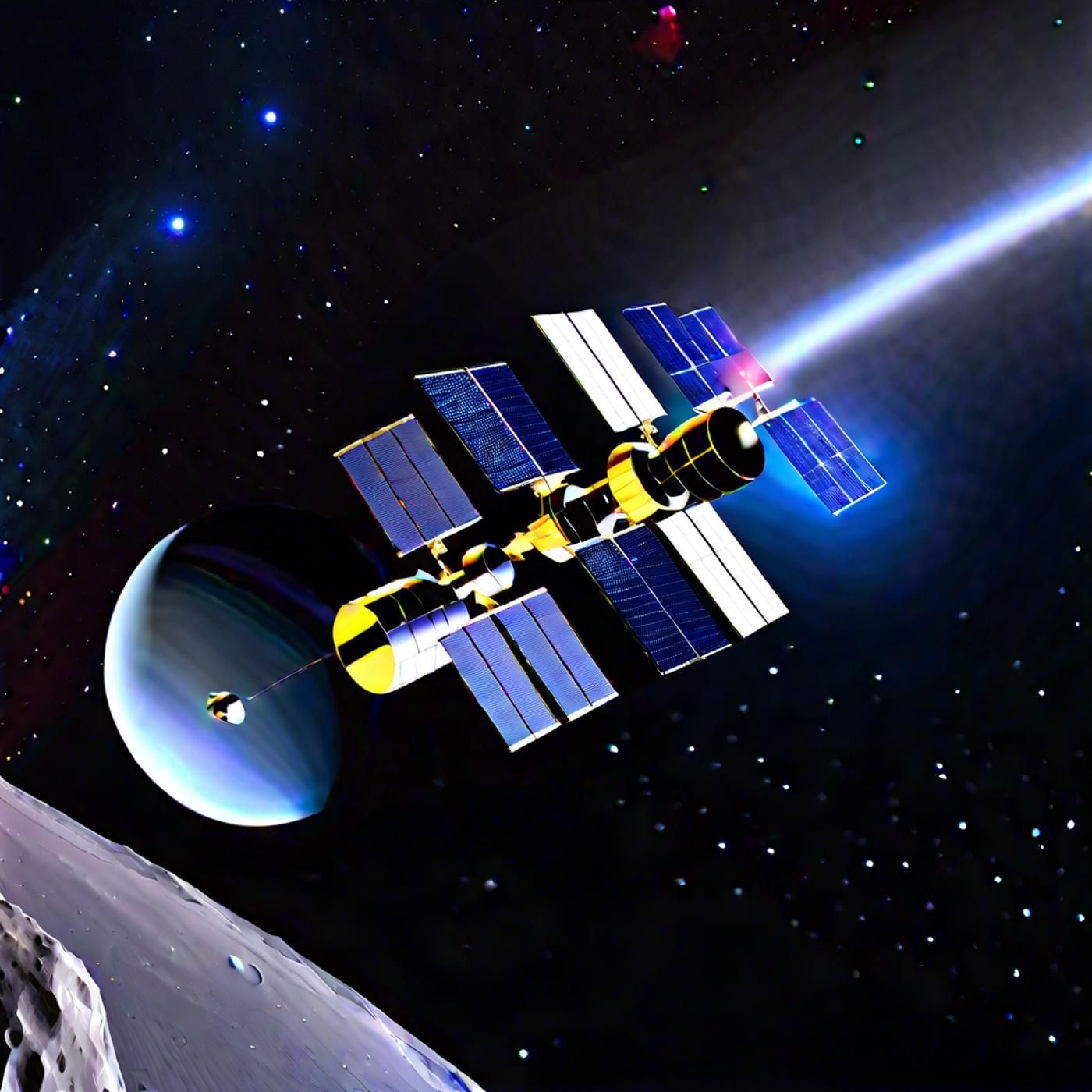S03E73: Starliner's Return Delay & SpaceX's Genetic Revelations

Embark on a celestial journey with today's episode of Astronomy Daily - The Podcast, where your host, Anna, brings you the latest cosmic updates. We'll dive into NASA and Boeing's plans for the much-anticipated Starliner crewed return, exploring the...
Embark on a celestial journey with today's episode of Astronomy Daily - The Podcast, where your host, Anna, brings you the latest cosmic updates. We'll dive into NASA and Boeing's plans for the much-anticipated Starliner crewed return, exploring the technical challenges they face. Next, we'll uncover remarkable genetic findings from SpaceX's Inspiration4 mission, the first-ever all-civilian space expedition, revealing temporary DNA changes in space. We'll also delve into groundbreaking research on the growth of supermassive black holes over billions of years, providing new insights into their evolution. Additionally, we'll take a closer look at the mysterious fast radio bursts (FRBs) and what recent studies reveal about their origins. Finally, we'll discuss the significant challenges astronauts face in maintaining kidney health during long-duration space missions, especially future journeys to Mars. Stay with us for an exciting journey through the cosmos.
For an astronomical experience, visit our website at astronomydaily.io for the latest news, sign up for our free newsletter, and check out exclusive sponsor deals. Connect with us on YouTube, TikTok, X, and Facebook via @AstroDailyPod for engaging discussions with fellow space aficionados. This is Anna, reminding you to keep your gaze fixed on the heavens. Until our next stellar episode, let the cosmos ignite your curiosity and wonder. Clear skies and cosmic discoveries to all!
Support:
This podcast is better with your support: https://www.bitesz.com/show/astronomy-daily-the-podcast/support/
www.bitesz.com
Sponsors:
www.bitesz.com/nordpass
https://www.bitesz.com/show/astronomy-daily-the-podcast/sponsors/
Welcome to Astronomy Daily, your go-to podcast for all things celestial. I'm your host Anna. In today’s episode, we've got some exciting updates and fascinating stories from the world of astronomy and space exploration. We'll be diving into NASA and Boeing's plans for the much-anticipated Starliner crewed return. We'll explore some remarkable genetic findings from SpaceX's Inspiration4 mission, the first-ever all-civilian space expedition. Additionally, we'll uncover groundbreaking research that sheds new light on the growth of supermassive black holes spanning billions of years. But that's not all. We'll also take a closer look at new insights into the mysterious fast radio bursts, or FRBs, that have baffled scientists since their discovery. And finally, we'll discuss the significant challenges faced by astronauts in keeping their kidneys healthy during long-duration space missions, especially for future journeys to Mars. Stay tuned for these stories and more, as we journey through the latest in astronomical science and space exploration.
NASA and Boeing have announced a postponed return date for the Starliner spacecraft and its first astronaut crew from the International Space Station. Originally scheduled to undock sooner, the mission is now tentatively set for June 18. This delay allows mission analysts and engineers to address multiple technical issues that have cropped up during the spacecraft's stay on the ISS. Among the concerns is a "sticky" oxidizer valve, which could affect the spacecraft's propulsion system if left unchecked. Additionally, there have been reports of a new helium leak, adding to the four leaks already identified during its 24-hour journey to the space station. These issues need to be thoroughly examined and resolved to ensure a safe return. The mission launched from Cape Canaveral, Florida, on June 5, and represents a significant step towards Boeing's goal of securing NASA certification for future routine flights. The Starliner can remain docked to the ISS for a maximum of 45 days, giving NASA and Boeing a tight window to ensure all systems are operational before the planned undocking.
Weather conditions and the scheduling of other activities on the ISS, such as spacewalks, also factor into the revised timeline. If everything goes according to plan, the Starliner will land roughly six hours after undocking, targeting the White Sands Missile Range in New Mexico, Willcox Playa in Arizona, or other pre-determined locations, pending favorable weather conditions.
The Inspiration4 mission, hailed as the first all-civilian space mission, has led to some truly fascinating discoveries about the human body’s response to space travel. Originally launched in September 2021, this historic mission showed an unexpected and remarkable finding: the crew members' DNA markers appeared younger during their short stint in space. This phenomenon is linked to the elongation of telomeres—the protective caps at the end of chromosomes—which were found to lengthen while the crew was in orbit, a sign of cellular youth. However, this youthfulness was as fleeting as the mission itself. Upon returning to Earth, the crew's telomeres quickly reverted to their pre-flight conditions. This rapid reversion underscores the temporary nature of space-induced genetic changes. Despite these transient effects, the data gathered from the mission provides invaluable insights into how space environments can influence human biology, potentially informing future long-duration spaceflights and our understanding of human health in space.
Over the past few years, researchers have made significant strides in understanding the growth of supermassive black holes, thanks to a combination of forefront X-ray observations and cutting-edge supercomputer simulations. This groundbreaking research, conducted by a team led by Penn State astronomers, has revealed the most complete picture yet of how these cosmic giants have evolved over the past 12 billion years, spanning from the Universe’s infancy to the present day. Supermassive black holes, which can have millions to billions of times the mass of our Sun, have long posed an enigma to scientists. They grow primarily through two main channels: accreting gas from their host galaxies and merging with other supermassive black holes when galaxies collide. The researchers harnessed data from powerful X-ray facilities like NASA’s Chandra X-ray Observatory, the European Space Agency’s X M M-Newton, and the Max Planck Institute’s eROSITA telescope to measure this accretion-driven growth. Their analysis included over 8,000 rapidly growing black holes within a sample of 1.3 million galaxies.
The team also utilized the IllustrisTNG simulations to model the growth of black holes through mergers. By integrating observed data with these simulations, they were able to construct the most realistic growth history of supermassive black holes to date. They found that while accretion was the dominant growth mechanism, mergers also played a crucial role, especially over the last five billion years for the most massive black holes. This research highlights that black holes grew much more rapidly in the early Universe. By about seven billion years ago, the total number of these colossal objects was almost settled. Understanding the growth patterns of supermassive black holes not only provides insights into their formation but also into the evolution of the galaxies they inhabit.
Fast radio bursts, or FRBs, have puzzled scientists since they were first discovered in 2007. These short, millisecond-long bursts of radio waves have sparked numerous theories, with some suggesting they could be signals from extraterrestrial life. However, the exact origins and causes of FRBs have remained largely unconfirmed. A new study utilizing data from the Canadian Hydrogen Intensity Mapping Experiment, or CHIME, is helping to bring these cosmic mysteries into focus. By analyzing the properties of polarized light from 128 non-repeating FRBs, researchers have gleaned that these bursts likely originate from galaxies with conditions similar to our own Milky Way—modest in density and magnetic fields. This contrasts with previous studies focused on hyperactive repeating sources, which appear to come from denser, more magnetized environments. The distinction between repeating and non-repeating FRBs is crucial in refining our understanding of these phenomena. The study's lead author, Ayush Pandhi, emphasizes that this approach provides new insights into the environments and mechanisms that produce FRBs. While FRBs’ exact genesis remains a mystery, this research takes us a significant step closer to demystifying these enigmatic signals from the cosmos.
A new study has brought to light the significant risks posed to astronauts' kidneys during extended space missions, such as a journey to Mars. According to research led by University College London, prolonged exposure to galactic radiation could cause permanent kidney damage, which is a critical concern for the feasibility of long-term space travel. The study, published in Nature Communications, is the most extensive analysis of kidney health in space flight to date, even incorporating data from commercial astronaut flights. In space, the kidneys undergo structural and functional changes, with specific kidney tubules showing signs of shrinkage after just a month in microgravity. While initially thought to be primarily impacted by microgravity, the study revealed that Galactic Cosmic Radiation (GCR) also plays a significant role in this damage. Mice exposed to simulated GCR doses, equivalent to a Mars mission, exhibited permanent kidney damage.
The formation of kidney stones during space missions has historically been attributed to the build-up of calcium due to bone loss. However, this study indicates that space conditions fundamentally alter the way kidneys process salts, likely contributing to stone formation. More alarmingly, mice exposed to simulated Mars-mission radiation for two and a half years experienced irreversible kidney damage, suggesting that astronauts on a Mars mission could face severe health issues, potentially requiring something as drastic as dialysis on the return journey. Dr. Keith Siew, the study's first author, emphasized the importance of understanding these changes and developing new protective measures. Without significant advancements in technology or pharmaceutical interventions, extended missions beyond Earth's magnetic field may pose insurmountable risks to astronaut health. The study underscores the necessity of addressing these biomedical challenges before embarking on round-trip missions to Mars. Developing solutions could also benefit medical science here on Earth, particularly in improving kidney tolerance during cancer treatments involving radiation. As researchers continue their work, ensuring the long-term health of astronauts remains a top priority for the future of space exploration.
Thank you for tuning in to this episode of Astronomy Daily. Don't forget to visit our website at astronomydaily.io for the latest news and past episodes. Follow us on social media by searching for Astro Daily Pod on YouTube, X, TikTok, and Facebook. Subscribe to our podcast on Apple Podcasts, Spotify, iHeartRadio, YouTube Music, or stream directly from our website. This is Anna saying bye bye, and until next time, - keep looking up!
New to Astronomy Daily - The Podcast?
Here are some great episodes to start with.




















